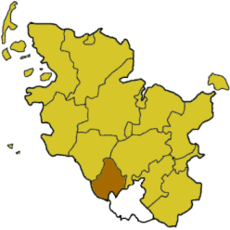Pinneberg (distrito)
Pinneberg | |||
|---|---|---|---|
| |||
| Dados | |||
Estado | Eslésvico-Holsácia | ||
Capital | Pinneberg | ||
Área | 664,11 km² | ||
População (31/12/2007) | 301.320 hab. | ||
Densidade | 454 hab/km² | ||
Placa de veículo | PI | ||
Website | www.kreis-pinneberg.de | ||
| Administração distrital | |||
Endereço | Moltkestraße 10 25421 Pinneberg | ||
Administrador | Dr. Wolfgang Grimme | ||
Partido | CDU | ||
Localização no Estado | |||
 | |||
Pinneberg é um distrito (kreis ou landkreis) da Alemanha localizado no estado de Eslésvico-Holsácia.[1][2]
Cidades e municípios |
Populações em 31 de dezembro de 2006:
Cidades:
| Municípios:
|
Estas cidades e municípios são chamados Amtsfreie Städte ou Amtsfreie Gemeinden por não pertencerem a nenhum Amt (vide abaixo). As cidades indicadas por asterisco (*) são sedes de um Amt.
Ämter (singular: Amt; português: ofício, escritório, secretaria), e seus municípios membros:
|
|
|
Referências
↑ «Statistikamt Nord: Bevölkerung in Schleswig-Holstein am 31. Dezember 2011 nach Kreisen, Ämtern, amtsfreien Gemeinden und Städten» (PDF) (em alemão). Statistisches Amt für Hamburg und Schleswig-Holstein
↑ «Statistisches Bundesamt – Gemeinden in Deutschland nach Bevölkerung am 31.12.2011 auf Grundlage des Zensus 2011 und früherer Zählungen» (em alemão). Einwohnerzahlen auf Grundlage des Zensus 2011


